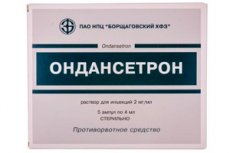新出版物
多美根
最近審查:04.07.2025

Domegan 是一种药物的商品名,其主要活性成分是昂丹司琼。昂丹司琼属于 5-HT3 血清素受体拮抗剂,用于预防由各种因素引起的恶心和呕吐。
昂丹司琼通常用于以下情况:
- 化疗:该药物用于预防化疗治疗中可能出现的恶心和呕吐。
- 放射治疗:它还可用于减轻放射治疗引起的恶心和呕吐。
- 手术后:昂丹司琼可用于预防手术后的恶心和呕吐。
- 药物治疗:昂丹司琼有时用于治疗由药物或其他药物引起的恶心和呕吐。
昂丹司琼可作为注射溶液使用。
使用前,务必咨询医生,以确定最适合您个人需要的药物剂量和形式,并考虑到您的疾病或治疗的具体情况。
適應症 多美加娜
- 化疗:Domegan 用于预防患者在化疗期间经常出现的恶心和呕吐。
- 放射治疗:它还可用于减轻放射治疗引起的恶心和呕吐。
- 术后恶心呕吐:Domegan可用于预防和治疗手术后的恶心呕吐。
- 药物治疗:有时用于治疗其他药物引起的恶心和呕吐。
- 胃肠道疾病:Domegan 可用于治疗各种胃肠道疾病,如胃炎、胃食管反流病 (GERD)、胃肠炎等,如果伴有恶心和呕吐。
發布表單
注射液:昂丹司琼溶液用于静脉注射,有时也用于肌肉注射。这种剂型适用于需要快速起效的情况,例如预防手术后或化疗期间的恶心呕吐。
藥效學
其药效学涉及与体内某些受体的相互作用,有助于减少对大脑呕吐中枢的刺激。
多美根属于选择性5-羟色胺(5-HT3)受体拮抗剂。与其他5-羟色胺拮抗剂不同,这类药物作用于5-HT3受体。昂丹司琼可阻断5-羟色胺对外周和中枢5-HT3受体的作用。
昂丹司琼主要作用于小肠和脑部,降低脑部呕吐中枢(例如呕吐中枢核)的激活。这可以减少化疗或术后引起的恶心和呕吐。
这种作用机制使 Domen 成为各种临床情况下控制恶心和呕吐的有效药物。
藥代動力學
- 吸收:昂丹司琼口服后吸收良好,通常在给药后1-2小时达到血药峰浓度。
- 分布:昂丹司琼的分布容积很大,表明它分布在身体的许多组织中。它可以穿过胎盘屏障,并存在于母乳中。
- 血浆蛋白结合:昂丹司琼仅限于血浆蛋白,约为70-76%。
- 代谢:昂丹司琼在肝脏中代谢,形成多种代谢物,包括羟基昂丹司琼和葡萄糖醛酸苷。主要代谢途径是通过细胞色素P450酶(主要是CYP3A4和CYP1A2)进行氧化。
- 消除:昂丹司琼主要经肾脏排出体外。成人体内半衰期约为4-6小时,老年患者或肾功能不全者半衰期可能延长。
劑量和管理
对于成年人:
接受化疗时,催吐的风险很高:
- 口服:通常起始剂量为化疗开始前 30 分钟服用 24 毫克。
- 静脉注射:0.15 mg/kg,通常三次剂量,第一次剂量在化疗前 30 分钟给药,后续剂量分别在第一次剂量后 4 小时和 8 小时给药。
对于引起呕吐风险较低或中等的化疗:
- 口服:化疗前30分钟服用8毫克,化疗后1至2天内每12小时服用8毫克。
- 静脉注射:0.15 mg/kg,每日三次。
术后恶心呕吐:
- 口服:麻醉前1小时服用16毫克。
- 静脉注射:麻醉前立即注射 4 毫克。
对于儿童:
化疗期间:
- 静脉注射:0.15 mg/kg,最多三次剂量,第一次在化疗前30分钟给药,第二次在第一次给药后4小时和8小时给药。
- 口服:剂量可能有所不同,但通常在化疗前 30 分钟服用 4 毫克,然后在第一次服药后 4 小时和 8 小时服用。
术后恶心呕吐:
- 静脉或口服:剂量和给药途径与成人相似,但要考虑到儿童的体重和临床需要。
一般建议:
- 昂丹司琼可以与食物一起服用,也可以不与食物一起服用。
- 监测患者的水合情况非常重要,尤其是呕吐严重时。
- 可根据个体患者的反应和医生的建议调整剂量。
在懷孕期間使用 多美加娜
孕期使用Domegan可能存在一些风险,因此需要谨慎使用。以下是一些科学研究的主要发现:
- 昂丹司琼与胎儿不良结局风险:一项丹麦研究发现,妊娠期使用昂丹司琼不会增加自然流产、死产、重大出生缺陷、早产、低出生体重儿或小于胎龄儿的风险。这项研究提供了令人放心的数据,表明昂丹司琼在妊娠期使用可能是安全的(Pasternak 等人,2013)。
- 西澳大利亚研究:研究发现,孕妇服用昂丹司琼可治疗晨吐和呕吐,虽然孕早期服用昂丹司琼不会显著增加重大出生缺陷的风险,但研究不能明确得出昂丹司琼在怀孕期间使用是安全的结论(Colvin 等人,2013 年)。
总体而言,这些研究表明,如果临床上有理由相信昂丹司琼的潜在益处大于可能的风险,则可以在怀孕期间使用昂丹司琼。
禁忌
- 对昂丹司琼或本药任何其他成分过敏。已知对昂丹司琼或类似物质(例如格拉司琼)过敏的患者应避免使用此药。
- 与阿扑吗啡同时使用。昂丹司琼不应与阿扑吗啡同时使用,因为这种组合可能会导致血压大幅下降和意识丧失。
- 患有心脏传导障碍(例如先天性或后天性QT间期延长)的患者。昂丹司琼可能会延长QT间期,从而增加发生严重心律失常的风险。
- 严重肝功能衰竭。昂丹司琼在肝脏代谢,严重肝功能障碍患者使用昂丹司琼可能会导致药物蓄积,增加发生不良反应的风险。
以下患者应谨慎使用昂丹司琼:
- 慢性心脏病,尤其是存在延长 QT 间期的危险因素。
- 电解质失衡,因为这可能会影响 QT 延长的风险。
副作用 多美加娜
- 头痛:这是昂丹司琼最常见的副作用之一。
- 嗜睡:有些人服用此药时可能会感到嗜睡或疲倦。
- 便秘或腹泻:一些患者可能会出现便秘或腹泻等胃肠道问题。
- 头晕:一些患者在使用 Domegan 时可能会出现这种副作用。
- 肌肉无力:极少数情况下,有些人在服用这种药物时可能会出现肌肉无力的情况。
- 抑郁或情绪变化:有些人可能会出现抑郁、焦虑或其他情绪变化。
- 过敏反应:在极少数情况下,可能会发生过敏反应,包括皮疹、瘙痒、面部肿胀或呼吸困难。
- 锥体外系症状:这些症状包括颤抖、胃痉挛或异常身体运动,可能在服用昂丹司琼后发生,尤其是在儿童中。
過量
Domene(昂丹司琼)过量服用会引起多种症状和并发症,包括头晕、头痛、嗜睡、心率加快(心动过速)、心电图(ECG)变化、甚至心律失常等副作用。
與其他藥物的相互作用
- 延长QT间期的药物:昂丹司琼可能会增加心电图上QT间期的延长。与其他药物,例如抗心律失常药物(例如,阿米达隆、索他洛尔)或抗心律失常抗生素(例如,红霉素、克拉霉素)合用,可能会增加心律失常的风险。
- 血清素药物:昂丹司琼与其他血清素药物(如选择性血清素再摄取抑制剂 (SSRI) 或曲坦类药物)同时使用可能会增加患血清素综合征的风险。
- 增强抗胆碱作用的药物:与具有抗胆碱作用的药物(如抗组胺药、某些解痉药和抗抑郁药)同时使用可能会增强昂丹司琼的抗胆碱作用。
- 增加高血压风险的药物:昂丹司琼与单胺氧化酶抑制剂 (MAOI)、某些抗抑郁药或血清素合成剂同时使用时可能会增加高血压危象的风险。
- 增强镇静或降低反射效果的药物:昂丹司琼与苯二氮卓类药物、催眠药或酒精等药物同时使用可能会增强其镇静效果。
注意!
為了簡化對信息的理解,本指令使用了藥物 "多美根",並根據藥物的醫療用途官方說明。 使用前請閱讀直接用於藥物的註釋。
描述僅供參考,不適用於自我修復指導。 這種藥物的需求,治療方案的目的,藥物的方法和劑量僅由主治醫師確定。 自我藥療對你的健康有危害。

